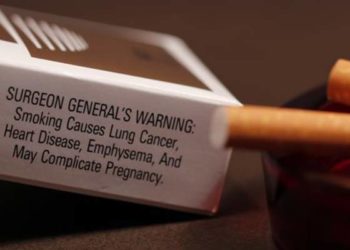Smoking cessation rates equivalent between most common pharmacotherapies
1. No differences in smoking cessation rates were detected between patients who received nicotine patch monotherapy, combined nicotine patch and lozenge therapy, or varenicline, 6 months and 1 year after follow-up.
2. Both combination nicotine replacement therapy and varenicline were superior to nicotine patch monotherapy in reducing withdrawal symptoms.
Evidence Rating Level: 1 (Excellent)
Study Rundown: Though the adverse effects of smoking are well-known, many patients still struggle to quit. Recent meta-analyses have suggested that combination nicotine replacement therapies (C-NRT) and varenicline may be more effective than nicotine patch monotherapies for smoking cessation. For a direct comparison, a randomized controlled trial examined the effectiveness of these three therapies combined with an intensive counselling program. At both 26 and 52 weeks after beginning treatment, there were no statistical differences in prolonged or 7-day abstinence between these therapies. In addition, smoking cessation was not statistically different between the three groups after stratifying smokers into high and low nicotine dependent groups. During the first week of quitting, there was a significant difference in withdrawal suppression, with the C-NRT and varenicline groups reporting less withdrawal symptoms than the nicotine monotherapy controls. This study highlights the difficulties in effective smoking cessation therapies and suggests that more rigorous pharmacotherapies may not greatly add to quitting success. However, while this study was well-designed and adequately powered, cessation rates of all therapies were lower than previous meta-analyses and only about 50% of patients were adherent across therapies.
Click to read the study, published today in JAMA
Relevant Reading: Treating Tobacco Use and Dependence: 2008 Update
In-Depth [randomized controlled trial]: This study enrolled 1086 patients (52% women) in Wisconsin who were willing to quit smoking. Notable exclusion criteria included prior suicide attempts, moderate to severe depression, hypertension of 200/100 mmHg or greater, use of bupropion, and prior hospitalization for cardiac disease or diabetes. Among recruited patients, 38.5% were prescribed varencicline, 38.5% C-NRT, and 23% nicotine patch monotherapy. All therapies included enrollment in an intensive counseling program. Follow-up data at 12 months was recorded for 84% of patients. There were no differences detected in the 7-day point-abstinence rates, which were confirmed with biochemical carbon monoxide testing at 26 and 52 weeks of treatment. The prolonged abstinence rates at 26 weeks were also not significant, with estimated cessation rates of 14.9%, 16.5%, and 15.4% for the nicotine patch, varenicline, and C-NRT, respectively. In a subgroup analysis, the time between waking and smoking was used as a corollary for dependence (less <30 min is more dependent while >30 min is less dependent). However, even when adjusting for dependence, no significant differences in cessation rates between therapies was found, nor were there interactions between dependence and treatment. At the end of the first week of treatment, both C-NRT and varencicline were associated with fewer withdrawal symptoms than nicotine patch monotherapy (C-NRT vs. patch mean difference 0.28, 95%CI 0.11–0.46; varenicline vs. patch mean difference 0.22, 95%CI 0.05–0.40), with no difference between the C-NRT and varencicline groups. At week 8, adherence rates were low; 45.2%, 49.3%, and 43% for nicotine patch, varencicline, and C-NRT, respectively.
Image: PD
©2016 2 Minute Medicine, Inc. All rights reserved. No works may be reproduced without expressed written consent from 2 Minute Medicine, Inc. Inquire about licensing here. No article should be construed as medical advice and is not intended as such by the authors or by 2 Minute Medicine, Inc.


![Active smoking cessation intervention may provide tangible results [Project CLIQ]](https://www.2minutemedicine.com/wp-content/uploads/2014/12/smoking-e1418644951268-350x250.jpg)




